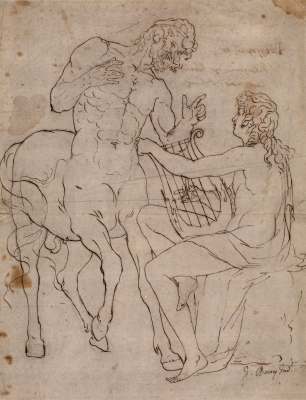This impressive early drawing was made by Bartolomeo Pinelli at the beginning of his career and shows the influence of his early mentor, Felice Giani. Pinelli produced prints, drawings, oils and terra-cottas; he was a pupil at the Accademia di San Luca and his earliest works, such as this, demonstrate an awareness of neo-classical ideas that were practiced by an international group of artists in Rome. Pinelli became known for his series of caricature-like engravings called Costumi romanae which were published in 1809, which illustrated views of the people of Rome and Naples. Working largely for the tourist market, Pinelli produced a series of publications.
Pinelli depicts the moment Minerva animates the first man, sculpted from clay by the titan Prometheus. It was a subject that was explored by a number of contemporary artists in Rome. At precisely the date Pinelli was working on this drawing, the great Danish sculpture Bertel Thorvaldsen was making designs for a roundel of the same subject, showing the same combination of elements: the seated, naked titan sculpting tool in hand admiring his creation, whilst standing Minerva animates the figure, an act symbolised by a butterfly. Felice Giani also produced a design of this subject, now in the Musée des beaux-arts du Canada, which shows the inherent drama of the creation myth. Pinelli’s design was made at a moment when the Prometheus myth was taking on new meaning. Prometheus increasingly became associated with human striving, particularly the quest for scientific knowledge. As the myths of antiquity became inflected with the emotional turmoil of romanticism, Prometheus began to embody the lone genius whose efforts to improve human existence could result in tragedy, an idea exemplified by Mary Shelley’s adoption of The Modern Prometheus as the subtitle for her 1818 novel Frankenstein. Pinelli’s work is more usually associated with watercolour genre scenes of Roman life, this richly inked early drawing shows his ability to capture the potential drama of neo-classicism at the beginning of the nineteenth century.



